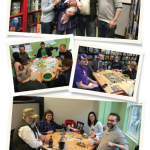Physical therapy (PT) for rheumatoid arthritis (RA) patients is crucial to treating their disease, but actually doing it can be grueling for many of them. But what if PT were something that they looked forward to? What if it were something they thought of as actually kind of pleasant?
That could change everything.
A group of researchers at Northeastern University in Boston is trying to harness the power of computer technology to do just that.
The project involves the use of a hands-free mouse that enables a patient with severe arthritis to move the cursor around the screen and to participate in a video game using only movements they can handle—essentially getting them to perform physical therapy while in play mode.
The project is a foray into “pervasive computing,” or the blending of wireless technology with electronics in an effort to have computing blend as seamlessly as possible with everyday life.
Technology Difficult for Some with RA
Maura Iversen, PT, DPT, SD, MPH, professor and chair of the department of physical therapy at Northeastern and associate editor of The Rheumatologist, says many patients find it difficult to use a computer in the traditional way—and patients complain to her that they’ve simply stopped trying. “These individuals may have—if they haven’t received aggressive early therapy or if their disease itself has been highly aggressive—a lot of derangement of the joints in their hands,” she says. “So managing a traditional keyboard or managing a traditional mouse, even if it’s a wireless mouse, can be difficult for them.”
Pervasive computing has been used successfully in other medical disciplines—for patients with spinal injuries and victims of stroke, for instance—but not for RA.
“There’s really nothing in the field at all for RA,” Dr. Iversen says. “This population of patients could be left behind if we don’t begin to think about how we can apply computing technologies to a vast array of individuals with chronic illness.”
Physical therapy is crucial not only to the health of the joints, but also in minimizing the cardiovascular risk that comes with RA, she says.
Therapeutic Microchips
Technology is infusing physical therapy more and more. Gym exercise logs, using flash drives inserted into weight systems, help patients and their therapists record and track progress. The use of accelerometers—a topic on which Dr. Iversen has a National Institutes of Health grant—has proven helpful by measuring the amount of physical activity patients engage in by assessing body movement.
But video games take it a step further, helping patients forget that they are doing physical therapy at all. The Wii video game system—in which players mimic what a person on the screen is doing—is now being used commonly by physical therapists for patients with many rheumatic conditions, such as RA. But Dr. Iversen thought a game could be more finely tailored for RA, and more effective.
In work she is doing with Northeastern colleagues Yingzi Lin, PhD, and Jeffrey Breugelmans, a PhD student, the connection with the computer is made using a cyberglove with sensors, which detects movements based on the amount of resistance the computer program is calculating. It also involves an eye tracker—the system knows where you’re looking based on infrared light bounced from the computer to the eye, and back again.
The eye tracker involves no wires, but the glove, at this point, still includes a wire, although it is long enough so that patients can move freely.
Breugelmans is now developing a computer game that he hopes will be interesting to RA patients while encouraging them to perform movements that will be therapeutic for them.
In the game, patients find themselves on a tropical island. By flexing their fingers, they can walk forward. By moving their eyes, they can change the view of the island that appears on the screen. With a bend of the wrist, they can bring up a view of an island map, seen from the top down as though you’re holding it like a tourist. The map includes points of interest that the player might want to visit—getting there, of course, by flexing those fingers.
Throughout the island are tropical “games” to play, such as picking up coconuts with a gentle pinch of the fingers and throwing them at targets, or taking a boulder to a hill and rolling it down.
The island theme is a careful choice. “The game is meant to be relaxing and not meant to put stress on the user,” Breugelmans says. “So there is no time limitation and they’re not forced to do anything—but they can if they want to.”
The game can be modified to require greater flexing in order to do the movements, so that it grows with the patient as the patient becomes capable of more. Healthy people have found the game easy to use, but it has not yet been tried in RA patients, he says.
Dr. Iversen and her partners are seeking funding to further develop the project.
Thinking Outside the X-Box
“Patients with RA are used to having pain,” Dr. Iversen says. “So they may say, ‘Well, it doesn’t bother me that much.’ There are many creative ways computers can assist in rehabilitation. We just need to think out of the box.”
In a related project, researchers at the University of Texas (UT) at Arlington, and at Northeastern, are developing “a smart health and well-being system” called RPLAY.
Fillia Makedon, Chair of UT Arlington’s computer science and engineering department, says it allows patients to do physical therapy at home while a computer system monitors their joint motions, motor performance, and other physiological indicators. The information gathered helps the physical therapy professional better gauge how the patient’s therapy is going. The system also includes fun incentives using interactive games and social media activities.
With these games available to the patients in their own homes, therapists might be able to successfully fill the gaps between PT visits that take place in the office. Instructions for physical therapy—just as directives to take medication—can be given to patients, but those instructions don’t matter much if the patient doesn’t do the exercise or take the medicine.
“Trying to get patients to be motivated to continue the program at home, so you as the expert can advance the program, is a challenge,” Dr. Iversen says. “So this is a way of helping to augment and maximize the benefit of physical therapy.” the rheumatologist
Thomas Collins is a freelance medical writer based in Florida.


